Spanish omelette
Hello again to everyone!
Today, I bring you a fantastic recipe of something that you will all surely know of. Today, I am going to tell you how to make a delicious Spanish omelette.
It is far easier than what you might imagine at first but, like everything in life, it does require some patience.
The last time that I made it, I managed to do so in 35 minutes, and it was stupendous. The best Spanish omelette that I have ever made.
As its name indicates, the Spanish potato omelette is a very typical dish in Spain. You will surely never find a Spaniard that hasn't tried this omelette at least once (whether or not it was good is another thing).
The best thing about this omelette is that you can combine it with whatever you like, whether it be with peppers, ham, olives, cheese, onion, mushrooms, seaweed... it goes with absolutely everything.
A Spanish omelette is normally eaten as a snack as an appetiser or in tapas, accompanied with a soft drink or beer or coffee. But, you could obviously eat a Spanish omelette whenever you like, no matter what time of day it is.
Let's begin with the most important thing: the recipe.
Ingredients:
- 4 medium-to-large potatoes.
- 1 medium onion (optional, although the onion will give it more flavour.
- 8 eggs.
- A handful of salt.
- Sunflower oil.
- Extra virgin olive oil.
Method:
Peel the potatoes with a potato peeler, or a knife if you don't have a peeler. Dice the potatoes and then proceed to peel and cut the onion, also dicing it.
An easy way to dice them is to cut the potato in half on its longest side. What I mean by this is that you stand the potato up vertically and then cut down the centre. Then, taking one of the cut pieces, place it face down and cut in straight, vertical lines along the potato. Then turn the potato to make it horizontal, and resume cutting in straight lines, dicing the potato.
Try to dice the potato into thin slices (but also don't make the slices too thin) to make them easier to cook. (The next time that I make a Spanish omelette, I will take some photos of how to cut up the potatoes so that it is easier to understand).
Repeat the process you just used for the potato for the onion.
Continuing on, put a large frying pan and put it on the hob on the highest possible heat/ flame. Add the sunflower oil until the frying pan is more or less half covered and add the diced onion.
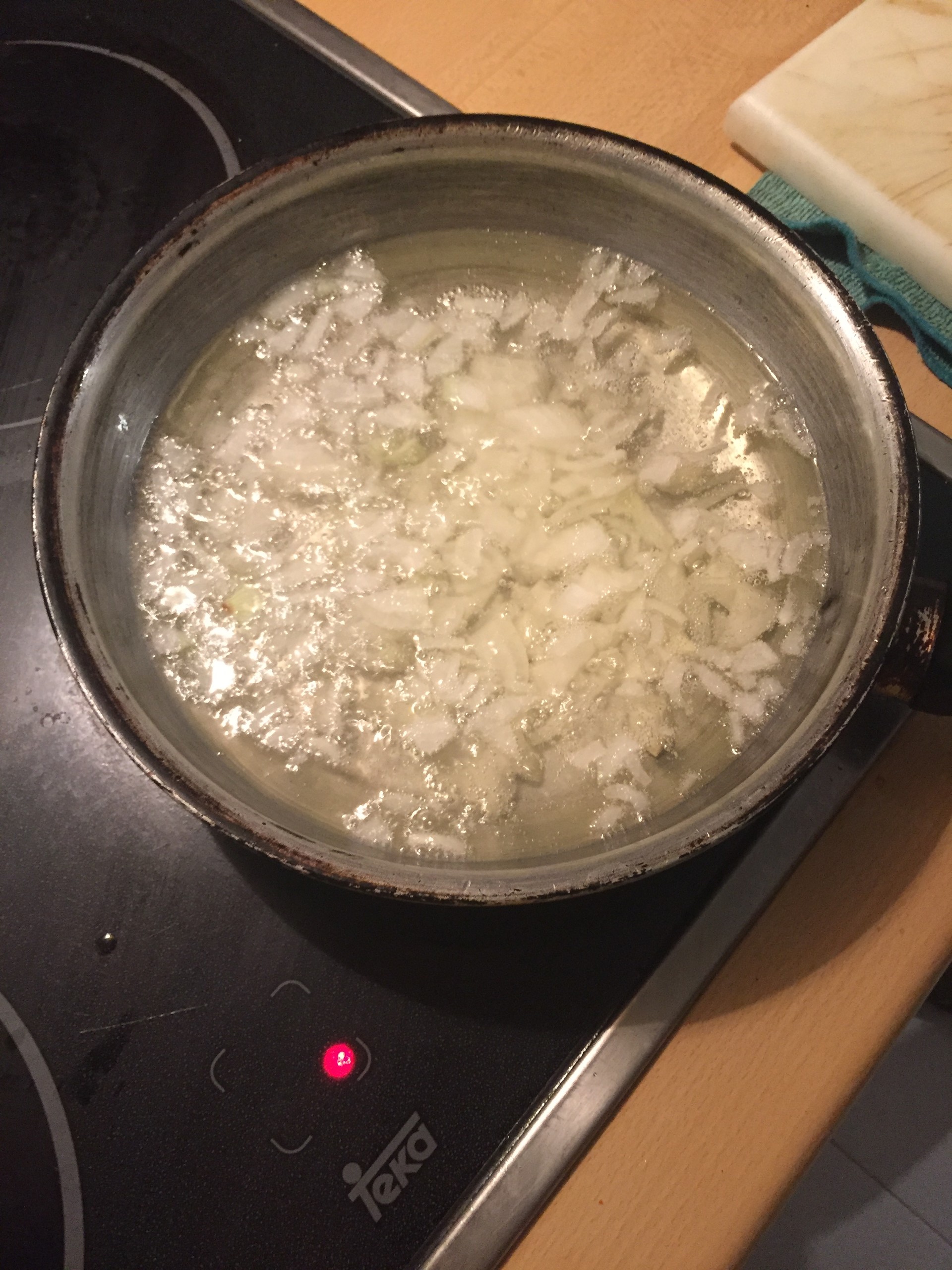
Leave them to fry a little until they turn a little brown and have softened a little. Then add the potatoes little by little. Then add the handful of salt whilst stirring. Do not forget the salt or else the omelette will end up being very bland and tasteless, and nobody ever wants to eat bland food.
Leave the frying pan on the highest heat whilst everything fries. Do not forget to occasionally stir so that all the potatoes cook and not just the ones on the bottom, and also so that they do not burn.
After 10 minutes, reduce the heat or flame to a medium setting and keep the frying pan over the fire.
Now it is just a question of having to wait for the potatoes and onions to soften up.
To see if this has happened, occasionally pick up a piece of potato and squash it between your fingers. If you can squash it then it is ready and you can take the frying pan off of the fire. If it is still hard, leave the frying pan on the fire for a little longer until the potatoes have softened.
Some of you might be wondering why I cook potatoes and onion in oil, but that is just the original recipe.
I used to think that you first had to boil the potatoes, normally peeled, in a pan with water and add a little salt, and then, when they were soft, drain the water, add the eggs and then add the mixture to the pan to cook it.
But no. That is not how it's done.
That way of making the potato omelette is for lazy people and for those who do not like to cook with oil.
But in all seriousness, I used to do it this way before but more than anything because I didn't know to cook the potatoes in the frying pan.
When I looked up the recipe for a Spanish omelette online, it always told me to first boil the potatoes (I began to cook when I went on an Erasmus placement in France and I was living by myself for the first time, so I had to learn to cook).
But now that I am back home, I told my father that I wanted to make a Spanish omelette and he, upon seeing me take out the pot to boil the potatoes, almost hit me over the head with it because of my incompetence.
And I will explain why. My father is a professional chef, he has a degree in culinary arts and catering and has 30 years of experience in fine cooking (he hasn't just cooked in local restaurants but also in elite restaurants). By that I mean that my father truly knows how to cook, and he told me that a Spanish omelette, in the original recipe at least, involves cooking the potatoes in the frying pan with oil. Well, say what you want, I believe him 100%.
So my father put the pot back in its place and told me to begin peeling the potatoes whilst he peeled and diced the onions.
And then, well, we did what I told you earlier to do: we fried the onions and potatoes in the frying pan.

Let's go back to the recipe.
After having fried the potatoes and onion in the pan, proceed to take them off of the fire and leave them to cool a little.
Then, put the potatoes and onions into a colander so that all the oil drains away.
Do not squash the potatoes or else they will become mashed potatoes, and that is not our intention at all. So take care when draining the oil.
Then, crack the eggs into a very big bowl. Beat them well and then add the fried potatoes and onion. Mix them together and then leave them to rest for a short while.
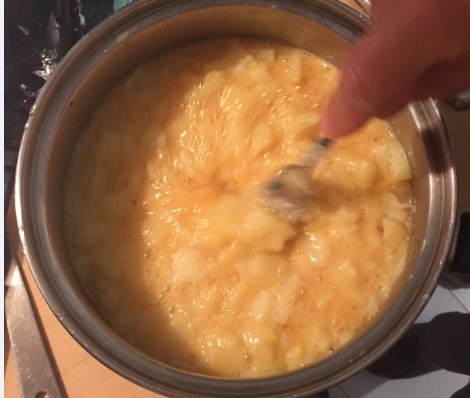
Take another pan (or you can use the same pan as before, but make sure to have removed the sunflower oil) and add extra virgin olive oil.
Here, in regards to the oil, you can use what you like.
My recommendation would be to cook the omelette in extra virgin olive oil because it is much healthier (although we have already fried the potatoes in sunflower oil, lol) and it also gives it a very Spanish flavour. But it depends on your tastes and preferences, so you can use any oil you want.
In regards to the quantity of oil that you should put into the frying pan, less is more. Effectively, you would use the same amount as you would when making any other omelette; enough so that it doesn't stick to the pan but not too much so that it becomes greasy.
Leave the pan and oil to heat up over a high temperature/ large flame for a little while, but also not for too long otherwise the oil will burn and the omelette will stick to the pan.
Once the oil is warm, add the potatoes, eggs and onions. Now, here comes the trick for the omelette to end up juicy and soft on the inside.
When you pour the mix into the frying pan, wait a little while for the bottom to cook (usually no longer than 20 seconds) and then move the pan around and rotate the omelette so that the part that was touching the bottom of the pan now faces up.
By doing this the omelette will not end up raw on the inside and burnt on the outside. Because if, once you pour in the mix, you leave the omelette until the underneath is fully cooked before flipping the omelette, everything will be ruined because the eggs on the inside will not cook and it will be difficult to flip them.
So when you pour the mix into the pan, wait a moment and then stir.

Afterwards, reduce the fire a little to a medium temperature so that the omelette can cook well without burning underneath. This usually takes around seven or eight minutes.
Then proceed to flip the omelette.
My father can do it by flipping it into the air, but I am a disaster at that. I always try it but the omelette breaks and it doesn't flip as a whole. So, an easy way to flip it is to take a flat plate that is either the same size or bigger than the frying pan and put it over the pan.
Then lift the pan and turn it over so that the omelette lands on top of the plate. Then, quickly, put the frying pan back on the hob and proceed to put the omelette back into the pan, raw-side down, carefully so that it all goes into the pan and nothing is left on the plate.
And, just as before, leave it to cook.
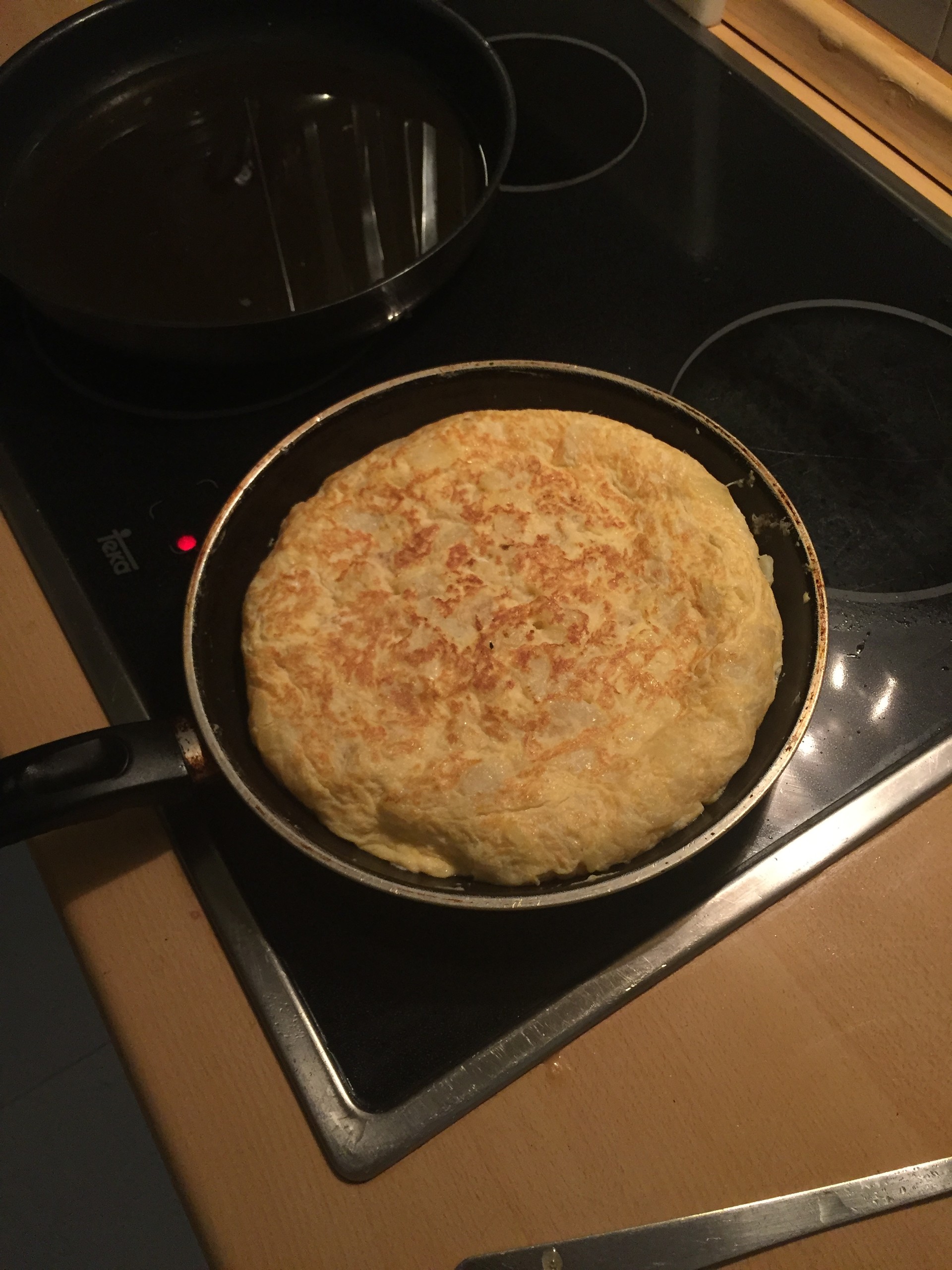
A curious fact for those that are reading this and are not Spanish is that the population of Spain is split into two groups. One group is the people that prefer a Spanish omelette to be undercooked and almost sticky, essentially it is not well cooked and the egg is still a little raw and liquidy. And the other group of people are those that like the omelette to be well cooked so that there is no raw egg.
But I am more or less in the middle. I don't like it if it is very greasy and liquidy because I feel funny just by thinking about raw eggs, but I also don't like it to be overcooked because then it is very dry and it can feel as though it's stuck in your throat. So for me, it is best somewhere in the middle. Juicy, but not liquidy.
Depending on what you like more, you can take the omelette out of the pan, or the pan off the fire, sooner or later to then serve on a plate.
And that is everything. :)
You now have your 100% Spanish potato omelette You can already see how quick and easy they can be to make.
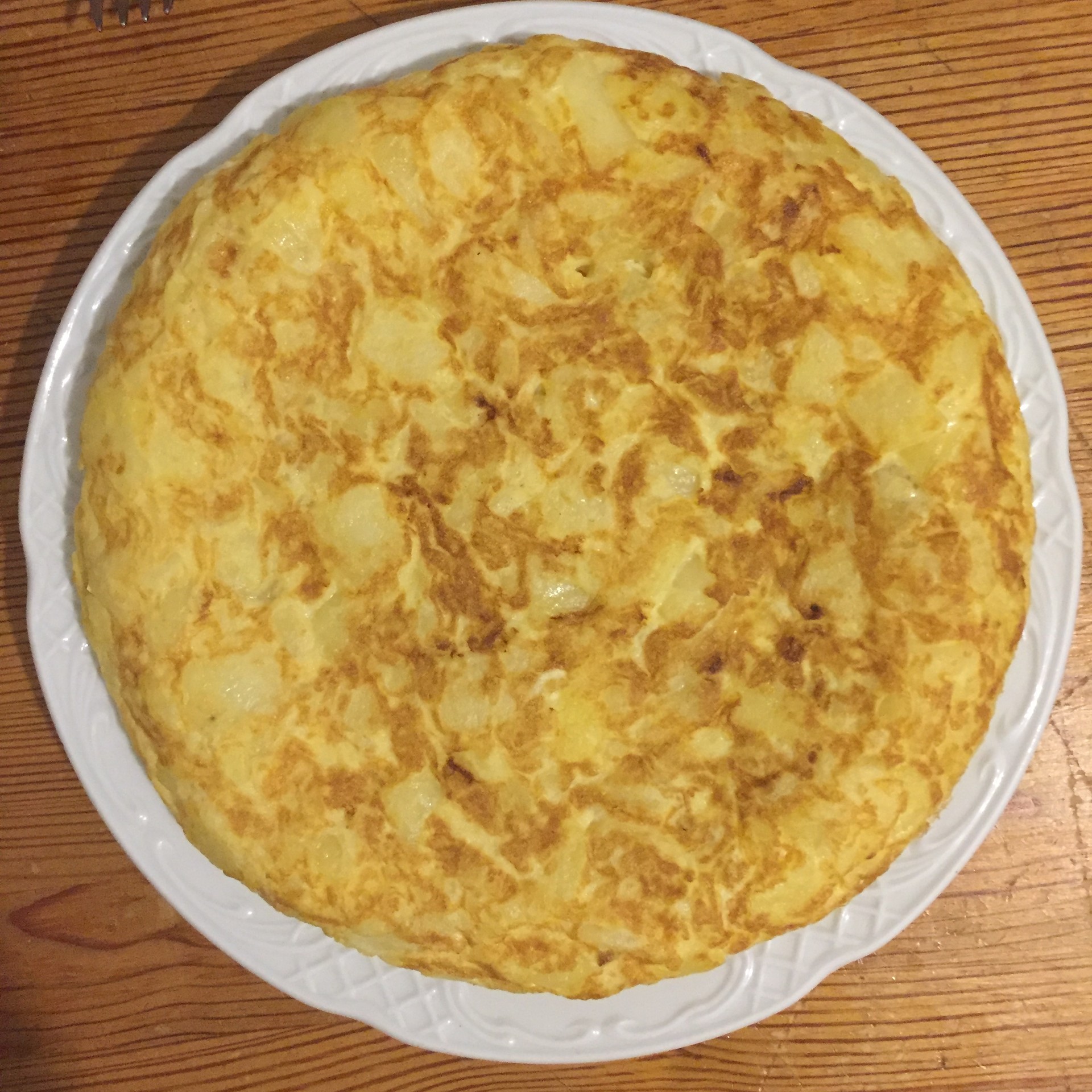
*Tips:
As I said before, the best way to make a Spanish omelette is to fry the potatoes in the oil so that they can cook until they are soft.
If you would prefer to boil them in water then that's not a problem, but it won't have the same flavour as when you cook them in oil.
Another thing. Just like with cooking the eggs, the Spanish population is also divided over whether or not to add onions. Some like it with the onion in the omelette and some like it without the onion, so it's just potato and egg.
I am one of the people that prefer it without the onion because there are people that don't know how to cook it well and they end up being crispy when you eat the omelette and I don't like that at all. The omelette should be soft, without any crunch.
But, after cooking the onion in the oil to soften up, the truth is that I was very surprised at how smooth they were and the flavour that they gave to the omelette.
For those that don't like onions (like myself), do not worry, if onion is added to the omelette it won't taste purely of onions. It's more that you would note the flavour.
Anyway, the Spanish omelette is fantastic, to me.
Another piece of advice that I will give you, targeted mainly at beginners in the kitchen and those who have never eaten a Spanish potato omelette is to half cook it. This means to say that it won't be too sticky due to being raw, nor will it be dry due to being overcooked.
Another variant in recipes for a Spanish potato omelette is the addition of adding canned red peppers when you go to mix together the potatoes with the eggs; and if you do not have a can and you only have fresh peppers, you can cook them a little in another pan and then add it to the eggs, or put them as is raw, although they will be noticeably crispy.
You could also add mushrooms. If you do add mushrooms then it is better if you cook them first.
One last thing.
I added grated cheese inside my omelette. As though the omelette were bread, I cut along the length of it to open it up and be able to put some grated cheese on the inside. Then I "closed" the omelette so that the cheese would melt and mother of all things good, it was delicious.
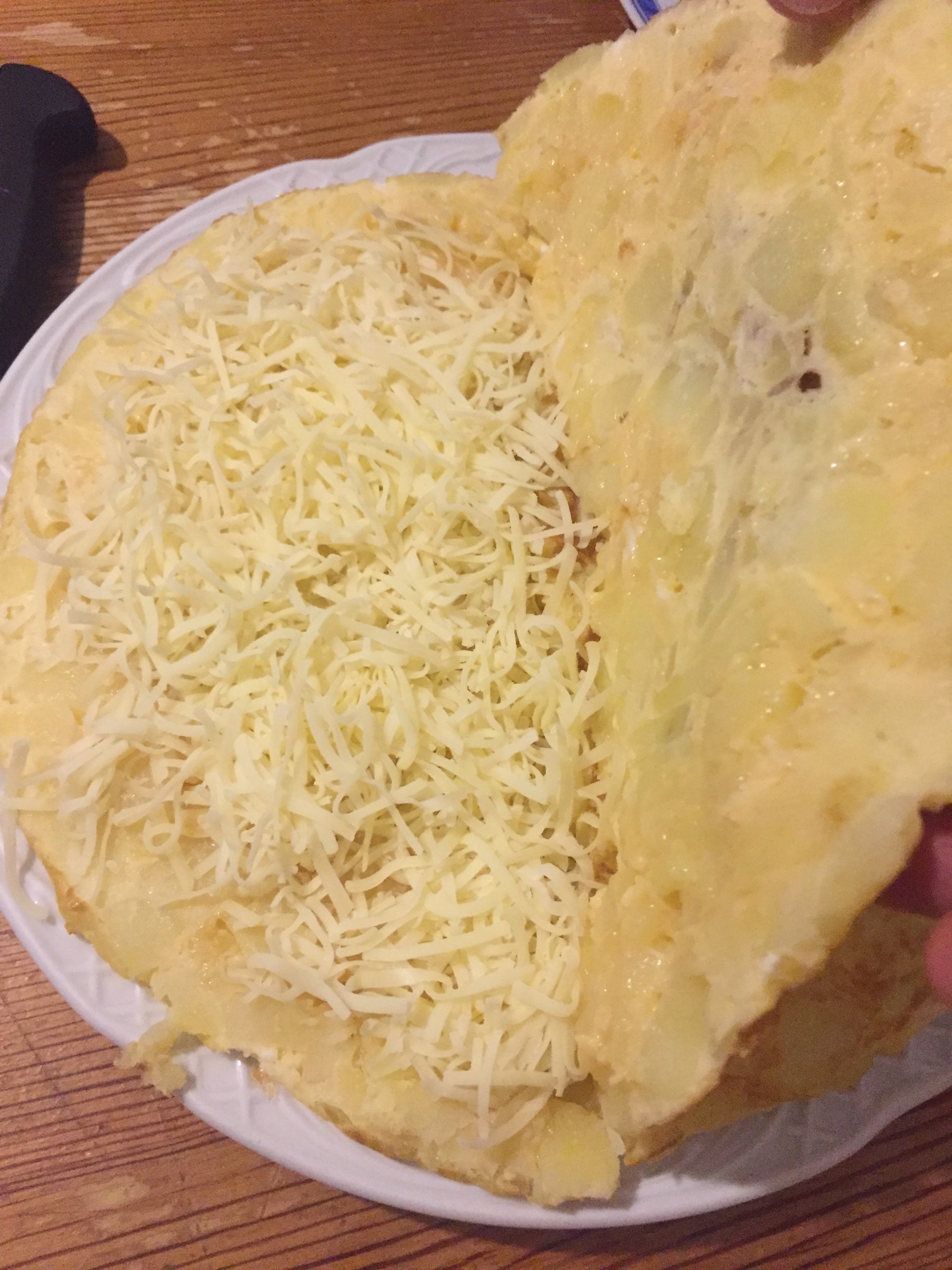
And that is everything for today.
I hope that these turn out as nicely for you as they have for me but if not then, as you will already know, keep trying without losing hope or motivation, as everything comes with patience and effort. ;)
Photo gallery
Content available in other languages
- Español: Tortilla de patatas española
- Italiano: Tortilla di patate spagnola
Want to have your own Erasmus blog?
If you are experiencing living abroad, you're an avid traveller or want to promote the city where you live... create your own blog and share your adventures!
I want to create my Erasmus blog! →










Comments (0 comments)